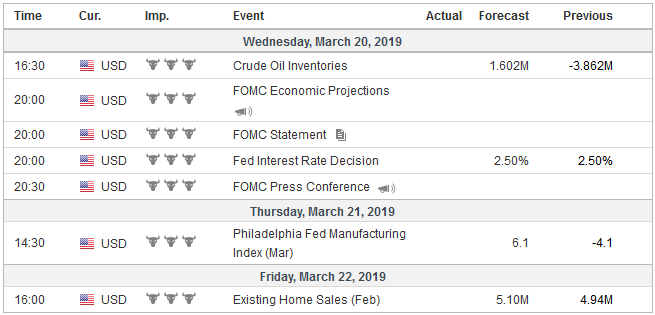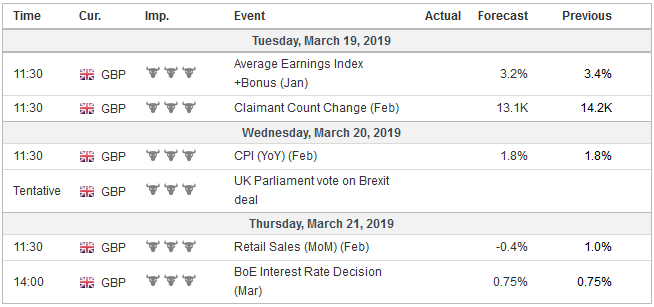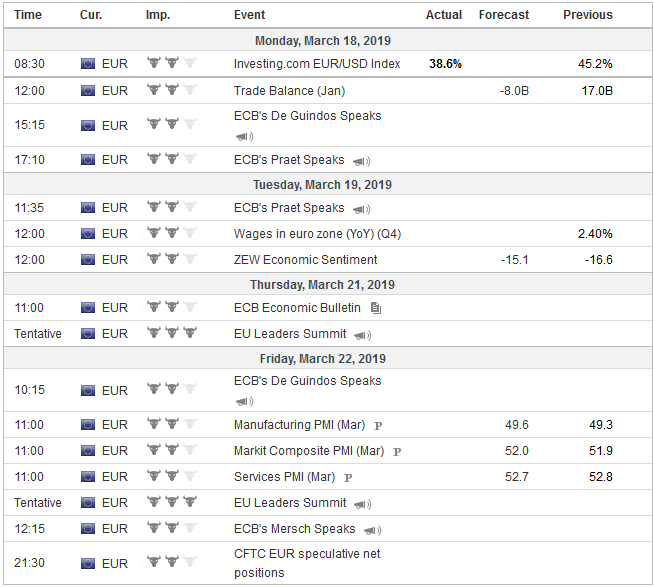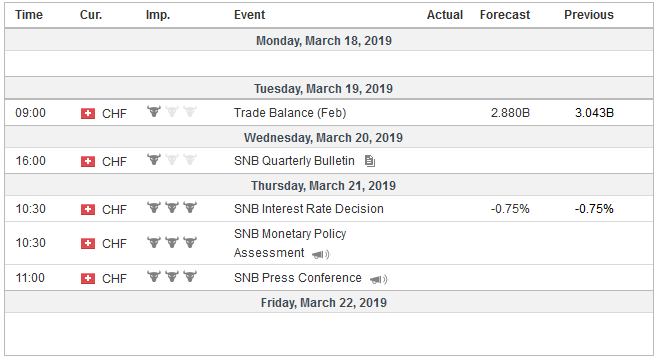Three events next week will shape the investment climate. The Federal Reserve meets and will update its forecasts and guidance. The British House of Commons may vote for a third time on the Withdrawal Bill before Prime Minister May heads of the EU Summit to ask for an extension of the UK leaving the EU. The eurozone sees the flash March PMI, with great hope that the green shoots of spring will be evident.
There is little chance of a change in policy at the FOMC meeting. The meeting is important because the Fed’s verbal communication has changed dramatically since the December projections. The Fed’s thinking about its balance sheet has also evolved. Often officials make small incremental changes to their forecast, but it could be a step function this time.
That said, the Fed’s view of the economy has probably not changed materially. The economy hit a soft patch at the end of last year and early this year as various crosscurrents hit, but the underlying fundamentals remain frim. Financial conditions tightened dramatically, but have eased nearly as quickly. The S&P 500 is up over 12% since the start of the year. The Federal Reserves’ real broad trade-weighted dollar index fell in both January and February, to snap an 11-month rally. US interest rates remain below Q4 18 levels. The 10-year note yield was near 3.25% in early November and finished last week below 2.60% for the first time since early January. The two-year yield closed the week a little above 2.40%. It peaked shy of 3.0% four months ago.
The FOMC statement may not contain detail about its balance sheet plans. Powell mostly likely will in his remarks and the media will press as well. Generally speaking, the market has understood the Fed to say that the balance sheet unwind is likely to be completed this year (many expect late Q3 or early Q4). Issues of the duration of the portfolio or how to transition to Treasuries may not have been resolved yet. The Fed’s balance sheet was shrinking when the equities rallied in middle quarters of 2018 and when it sold off in Q4 18 and rallied in Q1 19, making a causal relationship improbable.
United StatesIn December, the median forecast for growth this year was shaved to 2.3% from 2.5%. The median dot for 2020 and 2021 was unrevised at 2.0% and 1.8% respectively. Like many private sector economists, officials will likely recognize that the economic weakness in Q1 may be more pronounced than anticipated and could trim their forecasts again. Growth forecasts need to be understood within the context of what is seen as the long-term prospects, which are understood as trend growth. The range of forecasts in December was 1.7% to 2.2% (in September it was 1.7% to 2.1%), so the median projection at the end of last year was for a little more than trend growth. The new update will put it back into the range. A forecast below the range would be understood as a dovish signal, of course, but the variable lag times, even projections of growth in the future years below the range of the long-term forecasts would impact the trajectory of policy. Federal Reserve Chair Powell indicated that he would like to see inflation accelerate before resuming the tightening cycle. In December, the median forecast for both the headline and core PCE deflator was pared to 0.1% to 1.9% and 2.0% respectively. The 2020 and 2021 median headline forecast did not change. It remained at 2.1% for both years, while the median core forecast was slipped 0.1% to 2.0% for both years. Core inflation readings have been soft and market measures of inflation. Meanwhile, the 10-year breakeven (spread between the conventional Treasury securities and inflation-linked instruments) has risen by about 20 bp from late last year to 1.93%. The two-year breakeven shot up from around 65 bp last December and early January to 1.985%. The University of Michigan survey of 5-10 year inflation expectations bounced between 2.4% and 2.6% last year and fell to 2.3% in February, matching the cyclical low set at the end of 2016. The preliminary March estimate jumped back into the range at 2.5%. Discussions of the dramatic drop in equities and yields in Q4 18, often do not include the collapse in oil prices from around $75 WTI and $85 Brent in late September/early October to $43 and $50 respectively by the end of 2018. Both have rallied more than 35% off the lows. Fed officials also see tighter labor markets this year with the median forecast for the unemployment rate to fall to 3.5% this year. It stood at 3.9% in December and last month was at 3.8%. In December, two of the seventeen officials anticipated that no hikes were necessary this year. It is easy to see how the four officials that saw one hike could join the standpat camp. Eleven Fed officials had foreseen the need for two or more rate increases, almost evenly divided (6/5 in favor of three). It seems unreasonable to expect them all to completely reverse themselves. The median forecast will still likely anticipate a hike. The market is not there. The January 2020 fed funds futures contract implies a 2.30% average effective rate. It is currently at 2.40%. |
Economic Events: United States, Week March 18 |
United Kingdom
|
Economic Events: United Kingdom, Week March 18 |
EurozoneThe European Central Bank recently chopped this year’s growth forecast by a third to 1.1% (from 1.7%) and warned that risks were still on the downside. Did they overreact? Investors did. They panicked in Q4 18, driving the Dow Jones Stoxx 600 down around 12.25% and pushing it back up almost 13% so far here in Q1. The flash Markit March PMIs will be reported at the end of the week. The composite reading will likely improve for the second consecutive month. The composite rose in only three months last year. If it did rise in March, it would be the first back-to-back increase since November and December 2017. In February it stood at 51.9. It averaged 52.3 in Q4 18 and 54.6 for the whole year. The German manufacturing sector has been hit by both domestic (diesel engine reliance) and foreign (slowing of China) shocks. The manufacturing PMI fell every month last year but July. It fell below the 50 boom/bust level in January and fell further in February. March may be the first increase since last July, but it may still be below 50. The same general pattern holds for EMU’s manufacturing PMI except that it slipped below 50 only in February. The eurozone service PMI has fared better as it is less sensitive to the global slowdown and trade disruption. It rose six times last year and was unchanged once. The service PMI peaked January 2018 at 58 and trended lower to 51.2 in December 2018 and January 2019. It rose to 52.8 in February, which matches the Q4 18 average. It seems to be a bit exaggerated. It is the largest gain since February 2016. The euro has retraced the ECB-induced losses in full. It had finished the night before the ECB meeting a little above $1.1305 and closed last week a touch above $1.1320. On the back of disappointing US industrial production and an unexpected decline in February manufacturing output, the euro reached almost $1.1345, its best level since March 4. We anticipate additional gains into the $1.1400-$1.1420 area in the coming days. With one-week volatility a little above 5%, the implied range would be around $1.1230 to $1.1430. |
Economic Events: Eurozone, Week March 18 |
Switzerland |
Economic Events: Switzerland, Week March 18 |
Full story here Are you the author? Previous post See more for Next post
Tags: #GBP,#USD,$EUR,Brexit,ECB,EMU,Federal Reserve,newsletter,U.K.,US
























